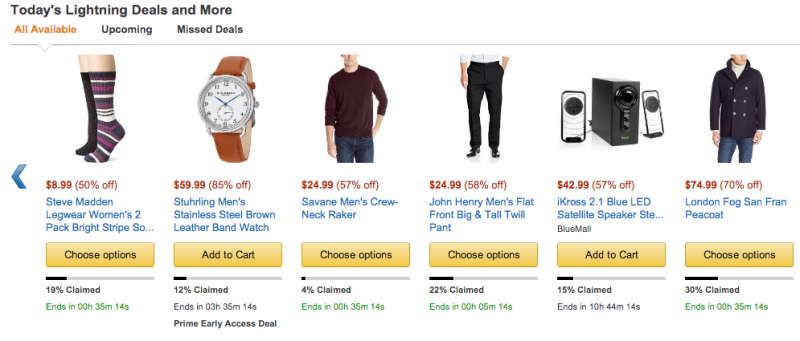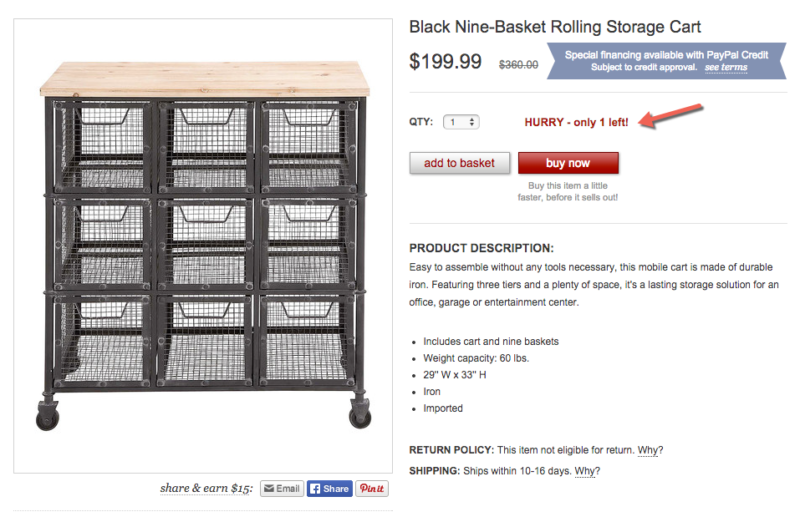9 Ways To Use Urgency Psychology To Improve Conversions
Hurry! Act now! Only a few items left! Contributor Neil Patel explains how these words and others tap into deep psychological motivations and drive conversions.

Sometimes, the best marketing moves are those rooted deep within human psychology. In fact, the greatest marketers are those who have the most in-depth knowledge of how the brain works.
One of the key features of the human brain involves urgency. In this article, I’m going to share how using this powerful principle can remarkably increase your conversions.
What Is The Urgency Principle?
Urgency is one of the most powerful aspects of human psychology. According to behavioral psychologists, urgent situations cause us to suspend deliberate thought and to act quickly.
Why Does Urgency Matter?
If you can create a stronger sense of urgency on your landing page or websites, then you can successfully spur people to do what you want them to do on your page (i.e., convert).
Urgency causes people to act quickly. Many of the problems that affect conversions are issues of cognitive friction — people think too hard, wait too long, or simply don’t respond to our calls-to-action. Raising the urgency level cuts through a lot of this delay to create a significant improvement to conversion rates.
How Do You Create Urgency?
The obvious question, then, is how do you create urgency?
There are specific tactics that we as marketers can do to raise the urgency level on a site. Here are some of my favorite.
1. Scarcity
Scarcity is one of the most powerful sources of urgent behavior. The scarcity bias states that when a person thinks that something is running out, they want it more.
In more precise terms, when an item is perceived as being scarce, its subjective value increases. Whether it’s a baseball card, an iPhone 6, an antique Model T, or some other thing, people want that item so much more, because there aren’t many left.
Scarcity can be created by the producer. If you create a product or service, you can intentionally limit the amount that you produce or deliver in order to raise demand. It’s as simple as that. If you say that you only have “four more left,” the desire for that resource will increase due to the fact that it is running out.
Here’s an example of this in an article published on Slate.

2. A Clock, Timer Or Countdown
In our modern industrialized world, the clock is the symbol of time. More specifically, it is the symbol of passing time. If you remind users that time is passing — that the clock is ticking — it raises the urgency level and compels action.

Amazon.com’s Lightning Deals all feature countdowns and imply scarcity.
Movie thrillers use this technique to raise viewer anxiety throughout a plot. We as marketers can use it to raise anxiety and urgency, thus compelling users to respond to our call-to-action.
3. Difficulty
One counterintuitive way to increase urgency is to make it difficult for people to act. The theory of effort justification states that people value something greater if they worked for it harder.
Thus, if you had to work extremely hard to earn $50, you would value that $50 more than if someone simply walked up and handed you the money.
The same is true in the conversion funnel. If people have to work hard to take action, then their urgency level automatically goes up in order to overcome the difficulty and accomplish the objective.
4. Loss Aversion/Catastrophe
The National Geographic show “Doomsday Preppers” is a fascinating study in human psychology. It shows us people who are acting with incredible urgency.
What is causing such urgency? They have a belief that their lives will be in danger due to some huge calamity or catastrophic situation. They act on this belief, and they act quickly.
Loss aversion is the human tendency to avoid losing things (anything). In fact, the desire not to lose something is greater than the desire to gain something.
If your marketing pitch makes it seem as if the user is going to lose something by not responding, then you are triggering the loss aversion response. If you can warn them of the “catastrophic” results of not acting now, then they will be more likely to experience urgency and act promptly.
The loss doesn’t actually have to be life-alteringly awful. For example, here’s a marketing email I recently received.

As an email marketer, I know how important it is to create timely emails with great subject lines — so learning that my carefully-created emails are going to be “toast,” that’s like a small catastrophe in my world. I am more likely to respond.
5. Competition
People love a good competition. Competitive situations are prime opportunities to unleash the urgency instinct and get people to act. Online games or sharing contests easily provoke a sense of urgency in the participants.
6. Time-Related Words
There are plenty of words that that you can sprinkle throughout your copy to increase urgency:
- Now
- Fast
- Quick
- Hurry
- Rapidly
- Close
- Approaching
- Never
- Seconds
- Again
- Over
- Instant
Words like these cause the mind to think urgently about time, thus improving a person’s likelihood of converting.

Hurry! (On Zulily.com)
7. Appeal To The Responsiveness Instinct
“Act now!” It’s one of the most often-repeated phrases in marketing literature.
In my opinion, it’s overused. It does, however, point to a very important urgency-inducing reality: If you tell people, “You’re a prompt and responsive person,” they will think “Yes. I am.” This subtle push towards urgency causes them to act quicker than they normally would.
The “early bird specials” offered by some restaurants or bars also cater to this tendency. People like to think of themselves as prompt and responsive. They act in a way that reinforces this belief.
8. Unpleasant Conditions Or Situations
The fact is, negativity increases click-throughs and response.
When a person finds themselves in a negative situation, they automatically respond with greater urgency. Even the reminder of a negative situation can kick the brain into urgent mode.
This principle is a parallel to the pain principle, which many conversion optimizers overlook. Anything unpleasant or negative about a marketing pitch is seen as a source of friction. In reality, however, it’s the negative feel or painful situation that creates urgency and compels action.
9. Pulling The Offer Away
One of the most effective urgency-inducers in sales is the takeaway. When you threaten to take an offer away, people are more likely to act in a hurry.
You can do this easily with a line like, “This is the last time we will be offering this class,” or “This webinar will not be recorded; Please sign up now.”
Conclusion
However you choose to implement the urgency principle, you’re virtually guaranteed to see some powerful results by using it. Urgency is something that people have a hard time responding to rationally, let alone cautiously. By compelling action right away, you gain an instant psychological upper hand.
How do you use urgency to improve your conversion rates?
Contributing authors are invited to create content for MarTech and are chosen for their expertise and contribution to the search community. Our contributors work under the oversight of the editorial staff and contributions are checked for quality and relevance to our readers. MarTech is owned by Semrush. Contributor was not asked to make any direct or indirect mentions of Semrush. The opinions they express are their own.
Related stories